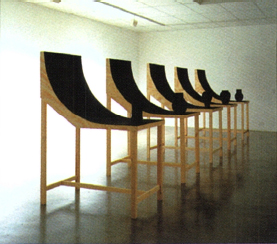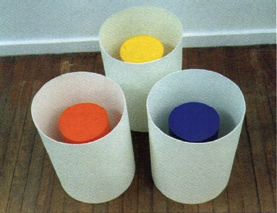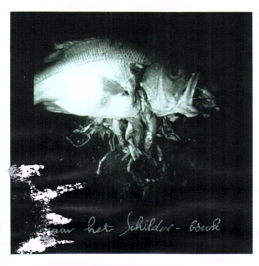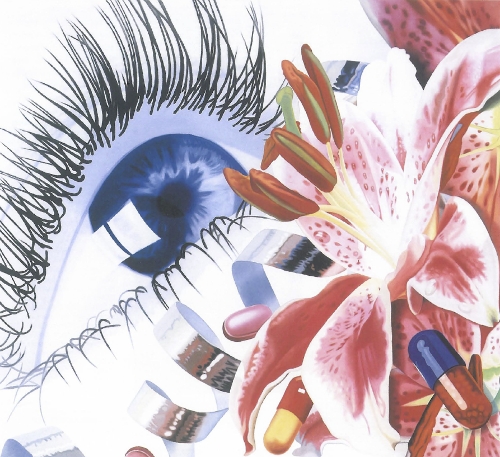
Contemplating this unbroken sequence of three big shows devoted to the oeuvre of Jacky Redgate, my mind returns to the middle, to Exhibition 2 - to an entrance into the first gallery space which placed me in direct viewing proximity to a line-up, roughly at eye-level, of regularly spaced, sparse cylinders: each patterned to incongruously dazzling effect with slim striped bands of alternating, pulsing colour. I had to look away, and found to the left, occupying the adjacent space and also hung in precise formation, the series of computer machined MDF shapes EQUAL SOLIDS – volume 25,196,000 cubic mm each. Each, Ross Gibson's catalogue essay informed, was modelled in replication of a formulaic mathematical response to Isaac Newton's intuitions (equally solid and abstract) How would they feel if I took them in my hands - heavy, or feather-light - impossible to gauge.
Up close to the shapes, and in relation to the wall-mounted, striped cylinders, the slightly furred, machined surfaces appeared warm and fulsome: the curving patination of the artificial wood-grain exposed by their manufacture, sensuous and serene by comparison to the hand-painted yet mechanical stripes. At the entrance, held thus momentarily, eyes flipping back and forth, it took a few moments to notice, to the right and low, cornered (shy?), the three larger, white cylinders, almost invisible against the white gallery wall and the soft mists of colour above them. Each contained a smaller, solid cylinder of primary (paint block) colour; each threw its separate auratic shadow quietly. And strangely - eyes cast back to the row of abrasively striped cylinders - the spaces between called for focus: colours dancing softly, sweetly where the stridency of the objects had repelled.

In the second gallery: a series of citations, replications, more plays with and across negative spaces; a tiny (wee) replica of Duchamp's purloined urinal, too high, too small to be ready-made, made-ready (for what?). Fresh Windower, a replication of Duchamp's Fresh Widow, its dark spaces, its obscured views occluded by dense serried panes, by textured stretches of kangaroo hide, shark skin, views deflected into rather than out upon, lost, vicariously possessed horizons. Adjacent, a solid still-life: set at coffee table height, its negative spaces mapped and claustrophobically cast, Untitled, from Anonymous (probably Daguerre, or Niepce de Saint-Victor), table prepared for a meal. And a series of boxes, containing palpably present absences, tempting a touch that found nothing (and was pleased).
At the back, occupying the third gallery, lined up, again with implacable precision, a series of sculptural forms reminiscent of tables set up in readiness for photo-shoots: Untitled (work in 5 parts). Each a blond pine construction bearing in stark and sinuous contrast, a dense matte black arch, a modelled citation of the curved paper backdrop used for isolating and lighting the photographic object. And upon each, an object (a vase, also painted dense, matte black) that appeared and disappeared depending upon the viewing position adopted, the conventional/stable, frontal viewing position of an implied photographer being rendered impossible in favour of an oblique, tangential, or circuitous approach. The serial nature of these structures, their requirement for an active participation on the part of the viewer, as well as their raw yet precise manufactured materiality brought to mind the methodologies of Minimalist sculpture, an interpretive viewing position that also proved impossibly unstable given the materials listed, which ignored the materiality of the structures themselves, citing as materials instead (along with the ceramic and acrylic that comprised the body of the vase shapes), the dates and names of certain specific paintings - a Matisse from 1943, a Redon from 1907, a van der Grooes from 1476-8 from which their traced form had been cast as solid shadow.
Casting my mind back to the previous and subsequent shows in this series, I recall other serialised plays with form and with formula, with systems of knowledge, with optical and theatrical illusion, allusion. Other assertions of the mutability of things as we think we know them. Other structures elaborately erected, displayed and documented, dimensions variously flattened, distorted, and otherwise opened into space: impossibly, improbably stable - incipiently, breathlessly unstable. Across the surveyed work, shifts are enacted in the physical and the emotional distance between things (objects, people, actions, ideas, sensations), between the perceiving body and the structures within which perception is by turns reflected and deflected, mirrored, multiplied. And a certain persistent resistance to closure: an opening always to affect and by extension, to affection.













